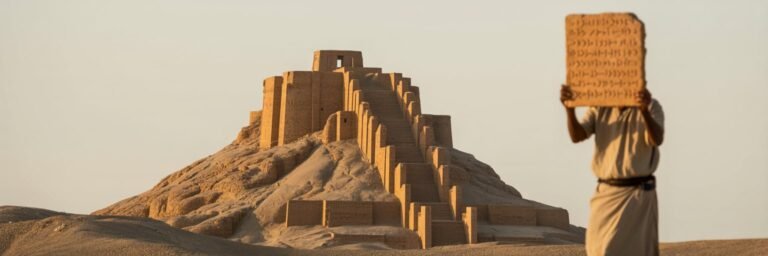INTRODUCTION
To the ancient civilization aficionado, Mesopotamia stands as one of history’s great pioneers, a cradle of human civilization. A sprawling nexus of culture, innovation, and genesis, it was the birthplace of countless “firsts,” including codified laws, written language, and complex political systems. Mesopotamia’s historical vastness is paved with numerous turning points, mitosis of the ancient world. This article surveys the top ten turning points that defined Ancient Mesopotamia. This essay peels back the layers of antiquity, revealing the jagged lines that sculpted history.
HISTORICAL BACKGROUND
Mesopotamia, Greek for “the land between the rivers,” is a region molded by the Tigris and Euphrates River system—present day Iraq and eastern Syria. The fertile crescent, as it’s known, was conducive to agricultural prosperity. Inhabitants could cultivate wheat, barley, and lentils, resources that gradually evolved from nomadic to settled societies around 8000 B.C. This shift was part of an epoch-defining era known as the Neolithic Revolution, changing the very fabric of human societies.
Among the early cultures that sprang from this fertile soil were the Sumerians, Babylonians, Assyrians, and Akkadians. Over the millennia, their cities flourished and fell, carving out empires that metamorphosed the landscape of human evolution.
THEORIES AND INTERPRETATIONS
1. The Development of Cuneiform Writing (3400 – 3200 B.C.): The Sumerians developed one of the earliest writing systems, Cuneiform, a complex system of symbols engraved onto clay tablets. Scholars interpret this turning point as a lynchpin for civilization, enabling vast communication, trade records, and monumental expressions of religion and law.
2. Rise of Sargon of Akkad (2334 – 2279 B.C.): Surgit Singh of the University of Delhi posits that Sargon of Akkad’s reign represented another significant pivot. He united disparate city-states, ushering in an age of imperialism—an early idiom of nation-building.
3. The Code of Hammurabi (1754 B.C.): This artifact signifies an essential milestone in humanity’s legal history. The French historian, Jean Bottero, deems the code as “a banquet of justice,” underscoring the Babylonian king, Hammurabi’s knack for codifying laws.
4. The Fall of Babylon to Persia (539 B.C.): Dated but resolute, the city of Babylon fell to Persia under the reign of Cyrus the Great—a turning point, says Professor Amélie Kuhrt of UCL, that marked the dawn of the Achaemenid empire.
MYSTERIES AND CONTROVERSIES
5. The Ubaid Period (5900 – 3800 B.C.): Scholars still dispute the reasons behind the archeological shifts in the Ubaid period, characterized by the introduction of large architectural structures. The controversial and still unproven ‘Ubaid Lizard men’ hypothesis has stirred academic debate.
6. Collapse of the Akkadian Empire (2180 – 2154 B.C.): Sir Max Mallowan, once a prominent archeologist and Mesopotamian scholar, stirred controversy with his theory that a climate catastrophe manifested as a turning point in the Akkadian Empire’s historic trajectory, shaking its societal bedrock.
SYMBOLISM AND CULTURAL SIGNIFICANCE
7. Ziggurats and Temples (2100 – 2050 B.C.): The rise of monumental Ziggurats, like the Ziggurat of Ur, imbued the landscape with deeply symbolic architecture. As potent symbols of religious ardor, they signified humanity’s striving towards the divine.
8. The Epic of Gilgamesh (2100 – 1200 B.C.): Transcribed in the 18th-century B.C. during the Babylonian reign and derived from earlier Sumerian tales, this epic has profound cultural significance—it marks the literary conceit to grapple with the human condition in the metaphorical narrative.
MODERN INVESTIGATIONS
9. Rediscovery of Mesopotamian Civilizations (19th Century A.D.): The 19th Century A.D. turning point, marked by rediscovery of Mesopotamia’s long-lost civilizations, was propelled by the tireless efforts of archeologists like Austen Henry Layard and Paul-Émile Botta. Their work unraveled Mesopotamia’s history, previously shrouded in the blotted ink of antiquity.
10. Modern Assyrian Identity (21st Century A.D.): Touching upon a present-day turning point, the assertion of modern Assyrian identity and the challenges that this contested ethnic group faces in its ancient homeland is an area of current socio-political research.
LEGACY AND CONCLUSION
Chiseled by the blade of time, Mesopotamia has left an ebullient legacy. From writing systems to imperial structures, legal codes to architecture, every turning point echoes within the annals of human history. Today, through the lens of modern research, we can appreciate the interlocked axles of cultures, turning wheels within the great machinery of civilization. Amid the mysteries, controversies, symbolism, and cultural breadth, Mesopotamia’s epic continues to unfold—eternally a turning point, perpetually a pivot in human saga juxtaposing our past, present, and future.






